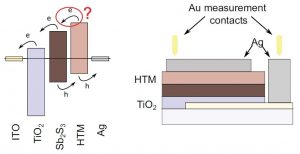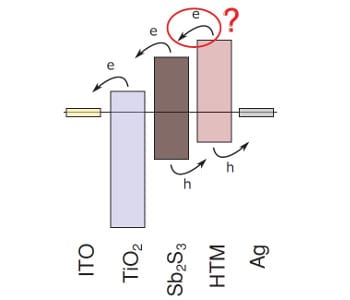A lot of research is devoted to putting less in to get more out – increasing conversion efficiency – which brings savings of all kinds, from material and fabrication costs to the end user running costs, to simply wasting less and being healthier for the environment.
When it comes to renewable energies, a lot of ongoing research is looking at new solar cell materials. One promising candidate is called stibnite (antimony sulphide – Sb2S3), the synthesis of which is fast and cheap, and can be easily scaled up, which is critical for industrial applications. Chemical bath deposition can be used to coat just a few nanometres of stibnite onto nanostructured metal oxide electrodes, which act as high-surface-area scaffolds. The nanostructure provides better electrical contact for the cell, and the ability to form such a thin film of stibnite reduces the material costs, as well as paving the way toward highly simplified fabrication processes.
 A group of researchers working at the University of Konstanz, Germany, has developed an optimized chemical bath process which enables the fabrication of high-performance stibnite-based hybrid photovoltaics without requiring a nanostructured scaffold. Their new flat geometry results in an enhanced open-circuit potential, attributed to reduced charge-carrier recombination.
A group of researchers working at the University of Konstanz, Germany, has developed an optimized chemical bath process which enables the fabrication of high-performance stibnite-based hybrid photovoltaics without requiring a nanostructured scaffold. Their new flat geometry results in an enhanced open-circuit potential, attributed to reduced charge-carrier recombination.
The optical properites of these devices were investigated both experimentally and through simulations, and it was found that absorption losses in the hole-transport material (polymer) strongly affect the overall device efficiency. This discovery points the way toward the further optimisation of such devices by increasing the exciton diffusion lengths in the hole-transport materials, decreasing recombination at the interface, enabling clear efficiency improvements in further work on stibnite photovoltaics.
Advanced Science is a new journal from the team behind Advanced Materials, Advanced Functional Materials, and Small. The journal is fully Open Access and is free to read now at www.advancedscience.com.

















